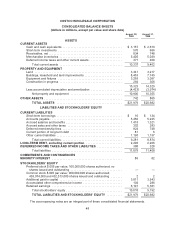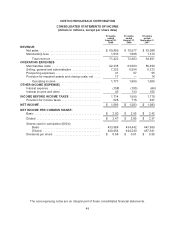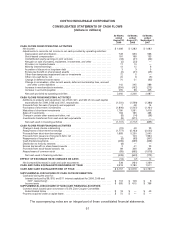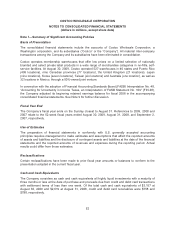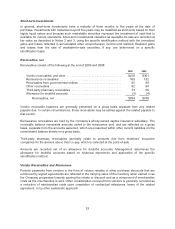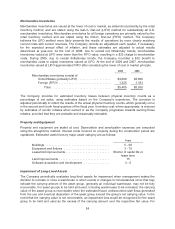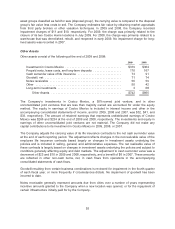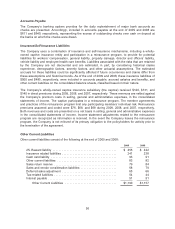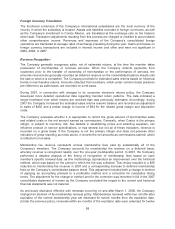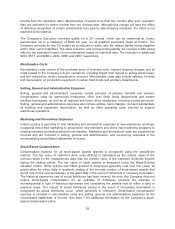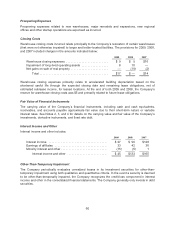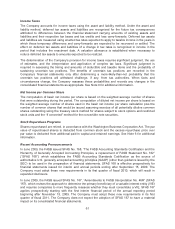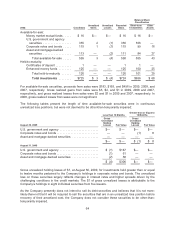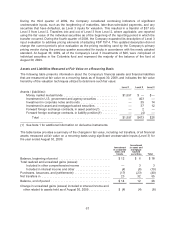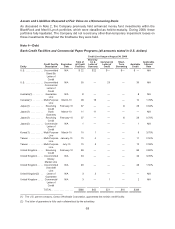Costco 2009 Annual Report Download - page 60
Download and view the complete annual report
Please find page 60 of the 2009 Costco annual report below. You can navigate through the pages in the report by either clicking on the pages listed below, or by using the keyword search tool below to find specific information within the annual report.Foreign Currency Translation
The functional currencies of the Company’s international subsidiaries are the local currency of the
country in which the subsidiary is located. Assets and liabilities recorded in foreign currencies, as well
as the Company’s investment in Costco Mexico, are translated at the exchange rate on the balance
sheet date. Translation adjustments resulting from this process are charged or credited to accumulated
other comprehensive income. Revenues and expenses of the Company’s consolidated foreign
operations are translated at average rates of exchange prevailing during the year. Gains and losses on
foreign currency transactions are included in interest income and other and were not significant in
2009, 2008, or 2007.
Revenue Recognition
The Company generally recognizes sales, net of estimated returns, at the time the member takes
possession of merchandise or receives services. When the Company collects payments from
customers prior to the transfer of ownership of merchandise or the performance of services, the
amounts received are generally recorded as deferred revenue on the consolidated balance sheets until
the sale or service is completed. The Company provides for estimated sales returns based on historical
trends in merchandise returns. Amounts collected from members, which under common trade practices
are referred to as sales taxes, are recorded on a net basis.
During 2007, in connection with changes to its consumer electronic returns policy, the Company
developed more detailed operational data regarding member return patterns. The data indicated a
longer timeframe over which returns are received than was previously estimated. Accordingly, during
2007 the Company increased the estimated sales returns reserve balance and recorded an adjustment
to sales of $452 and a pretax charge to income of $94 for the related gross margin and disposition
costs.
The Company evaluates whether it is appropriate to record the gross amount of merchandise sales
and related costs or the net amount earned as commissions. Generally, when Costco is the primary
obligor, is subject to inventory risk, has latitude in establishing prices and selecting suppliers, can
influence product or service specifications, or has several but not all of these indicators, revenue is
recorded on a gross basis. If the Company is not the primary obligor and does not possess other
indicators of gross reporting as noted above, it records the net amounts as commissions earned, which
is reflected in net sales.
Membership fee revenue represents annual membership fees paid by substantially all of the
Company’s members. The Company accounts for membership fee revenue on a deferred basis,
whereby revenue is recognized ratably over the one-year membership period. In 2007, the Company
performed a detailed analysis of the timing of recognition of membership fees based on each
member’s specific renewal date, as this methodology represented an improvement over the historical
method, which was based on the period in which the fee was collected. This review resulted in a $56
reduction to membership fee revenue in 2007 and a corresponding increase to deferred membership
fees on the Company’s consolidated balance sheet. This adjustment included both a change in method
of applying an accounting principle to a preferable method and a correction for cumulative timing
errors. The adjustment for the change in method and for the correction was recorded in full in the 2007
consolidated statement of income as the Company concluded the impact to the current and historical
financial statements was not material.
As previously disclosed, effective with renewals occurring on and after March 1, 2009, the Company
changed an element of its membership renewal policy. Memberships renewed within two months after
expiration of the current membership year are extended for twelve months from the expiration date.
(Under the previous policy, renewals within six months of the expiration date were extended for twelve
58


